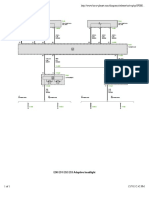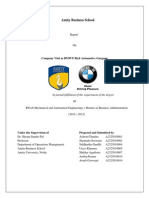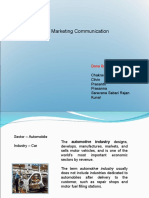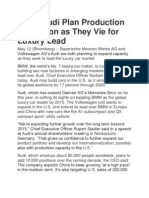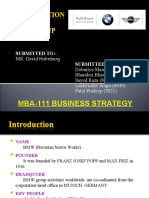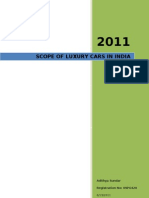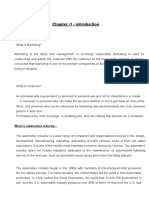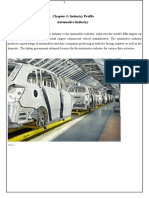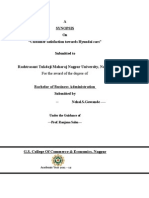Casestudy On BMW (A) - Vinay Asopa
Uploaded by
Raji AlamCopyright:
Available Formats
Casestudy On BMW (A) - Vinay Asopa
Uploaded by
Raji AlamOriginal Title
Copyright
Available Formats
Share this document
Did you find this document useful?
Is this content inappropriate?
Copyright:
Available Formats
Casestudy On BMW (A) - Vinay Asopa
Uploaded by
Raji AlamCopyright:
Available Formats
Economics of International Enterprises
Case study analysis
Faculty: Dr. Tamal Dutta Chaudhuri
Prepared By: Vinay Asopa (Class of 2011), Calcutta Business School
BMW Driving on Indian Autobahn Page 1
Economics of International Enterprises
Acknowledgement
I would like to thank my faculty Dr. Tamal Dutta Chaudhari for this time and expertise. His
knowledge has influenced me to look at different global business strategies from a different level
and evoke questions about their (global businesses) strategies and success.
BMW Driving on Indian Autobahn Page 2
Economics of International Enterprises
Abstract
In this paper we explore the various possible reasons as to why BMW changes its mode of
business from a dealership model to setting up a manufacturing hub in Chennai, India. We also
discuss possible economic theories that seem relevant and thus arrive to a conclusion whether the
set up is beneficial to both BMW as an organization and India as economy and growing
automobile market.
Introduction
Bayerische Motoren Werke (BMW), (literally English: Bavarian Motor Works) is a German
automobile, motorcycle and engine manufacturing company founded in 1916. It also owns and
produces the Mini brand (Mini Cooper) and is the parent company of Rolls-Royce Motor Cars.
The worldwide production network of the BMW Group is the backbone for growth in all our
global markets. Thanks to the close cooperation between all of the plants, manufacturing takes
place quickly and flexibly. This creates significant advantages in the international market. The
BMW Group currently has 17 production facilities in five countries:
Berlin plant, Dingolfing plant, Eisenach plant, Contract production in Graz (Austria), Goodwood
plant (GB), Hams Hall plant (GB), Landshut plant, Leipzig plant, Munich plant, Oxford plant
(GB), Regensburg plant, Rosslyn plant (South Africa), Shenyang plant (China), Spartanburg
plant (USA), Steyr plant (Austria), Swindon plant (GB), Wackersdorf plant.
The BMW Group currently engages in assembly with the help of external partners in the
following countries:
Jakarta, Indonesia; Kaliningrad, Russia; Cairo, Egypt; Kuala Lumpur, Malaysia; Rayong,
Thailand; Chennai, India.
The BMW Group is committed to maintaining and enhancing its presence in key markets
worldwide. BMW Group marketing subsidiaries are present in the following countries:
Argentina, Australia, Austria, Belgium, Brazil, Canada, Denmark, Finland, France, Germany,
Great Britain, Greece, Hungary, Indonesia, Ireland, Italy, Japan, Luxembourg, Malaysia,
Mexico, Netherlands, New Zealand, Norway, Philippines, Poland, Portugal, Russia, South
Africa, South Korea, Spain, Sweden, Switzerland, Thailand, USA.
The company is a charter member of the U.S. Environmental Protection Agency (EPA) National
Environmental Achievement Track, which recognizes companies for their environmental
stewardship and performance. It is also a member of the South Carolina Environmental
Excellence Program and is on the Dow Jones Sustainability Group Index, which rates
environmentally friendly companies.BMW has taken measures to reduce the impact the company
has on the environment. It is trying to design less-polluting cars by making existing models more
BMW Driving on Indian Autobahn Page 3
Economics of International Enterprises
efficient, as well as developing environmentally friendly fuels for future vehicles. Possibilities
include: electric power, hybrid power (combustion, engines and electric motors) hydrogen
engines.
BMW offers 49 models with EU5/6 emissions norm and nearly 20 models with CO2 output less
than 140 g/km, which puts it on the lowest tax group and therefore could provide the future
owner with eco-bonus offered from some European countries.
However, there have been some criticisms directed at BMW, and in particular, accusations of
greenwash in reference to their BMW Hydrogen 7. Some critics claim that the emissions
produced during hydrogen fuel production outweigh the reduction of tailpipe emissions, and that
the Hydrogen 7 is a distraction from more immediate, practical solutions for car pollution
Apart from passenger cars BMW has a long and successful history in touring car racing which
include Formula 1 Racing, Dakar Rally and many more.
BMW Driving on Indian Autobahn Page 4
Economics of International Enterprises
Automobile Industry in India
Indian automobile industry is one of the largest and fastest growing automobile industries
globally. Total capacity for passenger cars and utility vehicles in India stood at around 3.0
million units in 2009-10versus 1.25 million units in 2002-03, a CAGR of around 16 percent.
According to the Society of Indian Automobile Manufacturers, annual car sales are projected to
increase up to 5 million vehicles by 2015 and more than 9 million by 2020. By 2050, the country
is expected to top the world in car volume with approximately 611 million vehicles on the
nation’s road. One should keep in mind that these figures do not take into consideration the
second hand cars which hold a special place in the Indian automobile industry.
History:
Following economic liberalization in India in 1991, the Indian automotive industry has
demonstrated sustained growth as a result of increased competitiveness and relaxed restrictions.
Several Indian automobile manufacturers such as Tata Motor, Maruti Suzuki and Mahindra &
Mahindra, expanded their domestic and international operations. India’s robust economic growth
led to the further expansion of its domestic automobile market which has attracted significant
India-specific investment by multinational automobile manufacturers. In February 2009, monthly
sales of passenger cars in India exceeded 100,000 units and have since grown rapidly to a record
monthly high of 182,992 units in October 2009. From 2003 to 2010, car sales in India have
progressed at a CAGR of 13.7%, and with only 10% of Indian households owning a car in 2009
(whereas this figure reaches 80% in Switzerland for example) this progression is unlikely to stop
in the coming decade. Congestion of Indian roads, more than market demand, will likely be the
limiting factor.
In the 1980s, a number of Japanese manufacturers launched joint-ventures for building
motorcycles and light commercial-vehicles. It was at this time that the Indian government chose
Suzuki for its joint-venture to manufacture small cars. Following the economic liberalization in
1991 and the gradual weakening of the license raj, a number of Indian and multi-national car
companies launched operations. Since then, automotive component and automobile
manufacturing growth has accelerated to meet domestic and export demands.
Current Scenario:
BMW Driving on Indian Autobahn Page 5
Economics of International Enterprises
Most of the car manufacturers have already expanded their capacities over the past 5 years.
Honda Siel Cars India Limited is in advanced stages of setting up a new plant in Rajasthan. The
company plans to have an initial capacity of 60,000 units. French auto major Renault has put its
plan to introduce its cars in the Indian market from the upcoming Chennai Plant on hold
indefinitely. However, total capacities are expected to touch 3.75 million units by 2011 on the
back of major expansion plans of Tata Motors, Mahindra & Mahindra and Toyota Kirloskar
Motors. Analysts suggest that OEMs will incur a capital expenditure of Rs. 220-250 billion over
the next 2-3 years.
The Indian automotive ESO industry can sustain a 25 percent growth rate, based on the
expectation that it will increase its share in the total outsourced engineering and design spend
from the current 20 percent to 30 percent.
Thus, analysts estimate India’s auto ESO revenues to triple by 2013-14 to $1.8-1.9 billion,
assuming a 3-4 percent growth in total spends on auto engineering and design services over the
next 5 years. In comparison, the global ESO market will double from $3-4 billion in 2008-09 to
$6-8 billion by 2013-14.
BMW Driving on Indian Autobahn Page 6
Economics of International Enterprises
BMW’s Business Model
BMW’s core competence lies in luxury cars. Though after acquiring Mini BMW still focus on
luxury car market. They also manufacture bikes for sports enthusiasts and touring customers.
BMW increased its product offering after acquiring Rolls-Royce in 1998, BMW went super
luxury after this acquisition.BMW surprised all the leading luxury car manufacturers in Europe
when it acquired Mini in 2001. According to the Chief Executive, Helmut Panke ‘The product
initiative allows us to be focused on market segments that we see developing in the future. Tastes
are changing. Customers are slicing the market into more focused pieces. It's becoming more
differentiated…. The market is shifting. But satisfying the market's demand for new niche
products is a strategic risk anyone in the industry has to take. To be successful, you have to fulfill
100% percent of customers' expectations’. This statement gives a peak into the window of future
activities of BMW.
Today BMW offers super luxurious Rolls-Royce for the rich executives to sporty hatchbacks
aimed at upper-middle-class buyers. But it is worthy to note that BMW itself still continues to
roll out the 3-series, 5-series and the 7-series from its stable. BMW still continue to keep
production facilities of Roll-Royce and Mini independent from its original stable.
BMW motorcycles are specifically designed keeping in mind the touring tradition it does not
manufacture low powered motorcycles. The target market for such motorcycles is again the rich
and the affluent.
BMW has also stepped into manufacturing of luxury SUVs. This a new line that BMW plans to
profit from as across the globe the need for high performance and luxurious SUVs is at a rise.
In mid BMW surprised the luxury car makers when for the first time it introduced Series 1.
Series 1 was designed keeping in mind the need to have fuel efficient and mid-sized sedan
market. There are rumors that Series 1 was launched to offer low quality BMW for the mid-class
customers in Europe who cannot afford a expensive luxurious BMW. BMW has just kept Series
1 exclusive for the European market, though the company is considering offering Series 1 across
the globe.
BMW Driving on Indian Autobahn Page 7
Economics of International Enterprises
BMW & India
BMW entered the emerging Indian automobile market in December, 2006. Their initial strategy
was to provide with dealerships in India, the first dealership opened up in New Delhi (Dealer:
Deutschen Motors). Presently, 12 active dealership have opened up across India. In the first year
(2007) only 2% of the new car buyers in India knew about BMW brand. But in 2008, this figure
went up to 13%.
Andreas Schaaf, Country Head of BMW India, promoted the brand through strong finance
options by way of strategic alliance with Bajaj Allianz general insurance for the motor insurance
and with ICICI bank to offer the customized and personalized solution for the finance, and also
with the Orix Auto, for the leasing for the customers, these all services are being handled by a
separate department in India known as BMW Finance India.
In the year 2007, BMW opened their 1st assembly plant in Chennai with a capital investment of
Rs. 1.1 billion. The assembly line started manufacturing Series 3 & Series 5 cars solely for the
Indian customers. The production and sales subsidiary is wholly owned by the BMW Group. In
addition, they also set up a sales subsidiary in New Delhi as they plan to expand their operations
in Asia.
Mode of Entry in Unexplored Market
BMW has so far used three modes to go international: - 1) Export, 2) Acquisitions and 3)
Foreign Direct Investment (FDI). In case of the Indian market BMW initially use to export few
of its model and it was in 2006 when BMW funded their first assembly plant in Chennai.
BMW has gone acquiring other companies like Rolls-Royce and Mini.
BMW Driving on Indian Autobahn Page 8
Economics of International Enterprises
Speed Breakers in the Indian Market
BMW’s major concern was brand awareness and target market. The Indian automobile market
was immature pertaining to the luxury car. Few Luxury car brands available till 2004, near all
luxury cars were imported. The well recognized brand was Mercedes Benz, with the largest
market share in luxury segment in India.
So one challenge that BMW had for itself was positioning its product to create awareness and
brand equity. BMW had to look forward to go about competing with Mercedes Benz which has
been present in India for about 12 years.
Another major issue was that the Indian automobile market is still growing and only about 1.2%
of the total demand was buying luxury cars till 2006. Though the numbers have increased but
still only 3% of customers are buying luxury cars.
BMW had a task to cut competition (viz. Mercedes Benz) and also create market for luxury cars.
In 2010, the company has recorded a 73% growth in sales volume and had sold 6246 cars. BMW
market share as of 2010 is 41.64%. This growing result is because BMW has offered products
keeping in mind the preference of the Indian customers and road conditions. BMW has targeted
the young executive and the average age of the BMW buyers in India is 40 years.
OEM suppliers for various outsourced components are another problem faced by BMW. Many
local automobile suppliers cannot meet the standards of quality for BMW. Till date only few
Indian automobile part supplier are OEM suppliers to BMW.
Market size of luxury cars in India
with respect to aggregate market
BMW Driving on Indian Autobahn Page 9
Economics of International Enterprises
Dynamics of Trade
Technology Transfer
Since the invasion of BMW in India, many local automobile component manufacturers have
benefitted due to increase in competition. Many OEM suppliers like Apollo Tyres, Bosch, and
Asahi Glass so on and so forth. This is also a result of need of quality spares by foreign
companies. Though most of the components of BMW cars in India are imported from abroad but
lately Bosch India has started supplying ECU (Electronic Computer Unit) for two models of
BMW manufactured in India.
BMW’s set up in India has shifted attention of many international car manufacturers towards
India. Mercedes Benz planning to invest 700 million Euros to set up their plant in Chennai.
Tata’s are considering shifting their production to India for Jaguar Land Rover. Apart from such
luxury car makers Renault-Nissan has set up a plant in Chennai too with a production capacity of
400,000 units. Exotic car manufacturer Ferrari is planning to open dealership in India this year
itself.
All such automobile giants coming to India will significantly improve the standards of OEM
suppliers in India. With better know-how from such companies product development will be
inevitable. For instance, Asahi India Glass Ltd developed a high strengthen automotive glass
which is now being used in Mercedes Benz M-Class. As of now BMW has Rico Auto and
Sundaram Clayton as its global suppliers for differential case and brackets.
Porter’s Diamond
Through the Porter’s Diamond model we try to establish a conclusion of why BMW became
competitive in luxury car market in India.
BMW Driving on Indian Autobahn Page 10
Economics of International Enterprises
Firm strategy, structure & rivalry
Chance BMW has the first mover advantage in
this segment
Increase FDI from rival
firms BMW’s primary goal is to provide fuel
efficient luxury cars through their
Increase in Cost of
‘efficient Dynamics’ technology
production due to rise in
input prices Rival firms planning to set up
manufacturing units in India too
Demand conditions
Factor conditions
The Indian automobile industry is growing at
Large Capital Resource 16% CAGR and it is estimated to be the largest
automobile industry by 2020.
State of the art technology
BMW and other luxury car manufacturers are
Large number of OEM suppliers
anticipating a growth of 2-3% Y-O-Y for luxury
(subjected to BMW’s Quality)
cars in India. Thus better and faster
technological change will be evident
Related & supporting industries
Government
Local OEM suppliers will have to upgrade their
technologies if they wish to stay in business GOI may reduce excise duty
to promote such companies,
New technological upgrade may take place locally in improve roadways to suit
future such luxury cars
BMW Driving on Indian Autobahn Page 11
Economics of International Enterprises
North-South Trade & Economic Growth:
BMW’s entry in the India can be perfectly replicated in the North-South Trade model. The map
below shows BMW’s manufacturing facilities worldwide:
We assume that BMW has one manufacturing facility in USA to cater the needs of North
American market. So as to cater the need of the growing Asia Pacific market it has a number of
facilities in Asia to meet the demand. We also observe that all the research & development takes
place in the European manufacturing facilities. Thus, BMW is not transferring the latest
technology in India since most of the R&D is taking place at the Munchen plant (Germany).
BMW in order to achieve higher profit may have opened its production in India since the Indian
automobile ancillary is not technologically advanced to replicate their technology, even if the
domestic manufacturers would want to offer their products in comparison to BMW will not be
able to do so as the quality offered by BMW is far more superior than the local technology. As
mentioned earlier local ancillaries are upgrading their products but still BMW outsources its
majority of components from outside India. As and when Indian domestic ancillaries will be able
to replicate the quality of BMW, by that time BMW may launch hydrogen powered cars which
they are already working upon.
BMW Driving on Indian Autobahn Page 12
Economics of International Enterprises
Conclusion
We have mentioned various reasons for BMW entering the Indian market. The most logical
conclusion that we can drive out looking at the current scenario is that BMW wants to capture
the emerging luxury car market in India. There is news of BMW expanding its operations in
India by introducing high end motorcycles. So apart from the 4 wheel segment BMW is
interested to explore the 2 wheeler market which is a good sign for India and BMW.
We cannot confirm about the existence of North-South Trade model until we see that local
Indian suppliers do not emerge to become their global suppliers and BMW launches new and
improved models than that available in India right now. There are talks of setting up a R&D
center in China but that will only work to cater the conditions of Asia market specifically. No JV
has been established outside Europe to work towards the future cars. Although there has been a
tie-up between BMW and Mercedes Benz in 2008 to work on hybrid cars, but this collaboration
broke up in mid 2009. But BMW and Peugeot Citeron collaboration on engine development still
exists and in 2010 the two companies designed engine for the Mini Cooper that meets EU 6
requirements.
Reference:-
CRISIL industry report 2010 on Indian passenger car
www.bmw.com
www.team-bhp.com
Rediff Business
The Financial Times
www.wkipedia.com
BMW Driving on Indian Autobahn Page 13
You might also like
- Internal Assignment Project For Business EnvironmentNo ratings yetInternal Assignment Project For Business Environment18 pages
- Strategy Management - Bayerische Motoren WerkeNo ratings yetStrategy Management - Bayerische Motoren Werke5 pages
- Using The PESTEL Framework Carry Out An Analysis of The Target Country From The OrganisationNo ratings yetUsing The PESTEL Framework Carry Out An Analysis of The Target Country From The Organisation21 pages
- Planning and Development of BMW in Malaysia100% (1)Planning and Development of BMW in Malaysia13 pages
- Auto Industry: India in The Changing World OrderNo ratings yetAuto Industry: India in The Changing World Order16 pages
- Damodaram Sanjivayya National Law University VisakhapatnamNo ratings yetDamodaram Sanjivayya National Law University Visakhapatnam9 pages
- BMW's Business Strategy For Indian Market: by Swanand PashankarNo ratings yetBMW's Business Strategy For Indian Market: by Swanand Pashankar9 pages
- Intro To Management On Luxury Car Brands in IndiaNo ratings yetIntro To Management On Luxury Car Brands in India16 pages
- Automobile Sector - Impact of Indian Automobile Industry On The Global EconomyNo ratings yetAutomobile Sector - Impact of Indian Automobile Industry On The Global Economy6 pages
- Integrated Marketing Communication: Done byNo ratings yetIntegrated Marketing Communication: Done by22 pages
- VANSHIKA Industry Overview - Automobile - DraftNo ratings yetVANSHIKA Industry Overview - Automobile - Draft18 pages
- Demand Analysis & Forecasting - The Car Industry: Presented byNo ratings yetDemand Analysis & Forecasting - The Car Industry: Presented by31 pages
- BMW, Audi Plan Production Expansion As They Vie For Luxury LeadNo ratings yetBMW, Audi Plan Production Expansion As They Vie For Luxury Lead5 pages
- A Project Report On Measuring Customer Satisfaction Level and Sales Promotion in YamahaDocument TranscriptNo ratings yetA Project Report On Measuring Customer Satisfaction Level and Sales Promotion in YamahaDocument Transcript39 pages
- Steering Indian Automobile Industry: Towards GlobalizationNo ratings yetSteering Indian Automobile Industry: Towards Globalization8 pages
- Contents: 2. Competitive Analysis 3. Expansion Plans 4. PESTLE Analysis 5. Recent News 6. Conclusion 7. ReferencesNo ratings yetContents: 2. Competitive Analysis 3. Expansion Plans 4. PESTLE Analysis 5. Recent News 6. Conclusion 7. References10 pages
- Alt BMWGroupPressReleaseIndia02112005 01No ratings yetAlt BMWGroupPressReleaseIndia02112005 013 pages
- Chapter-1: Industry Profile Automotive IndustryNo ratings yetChapter-1: Industry Profile Automotive Industry49 pages
- Study OnCustomer Satisfaction in Mahindra & MahindraNo ratings yetStudy OnCustomer Satisfaction in Mahindra & Mahindra71 pages
- A Synopsis On "Customer Satisfaction Towards Hyundai Cars" Submitted ToNo ratings yetA Synopsis On "Customer Satisfaction Towards Hyundai Cars" Submitted To19 pages
- Enterprise Management Automobile Industry Business Cases: Renault Morocco, Tesla, Hyundai, TATA Motors, Daimler Mobility, ToyotaFrom EverandEnterprise Management Automobile Industry Business Cases: Renault Morocco, Tesla, Hyundai, TATA Motors, Daimler Mobility, ToyotaNo ratings yet
- BMW Motorrad Parts Warranty Statement - Pdf.asset.1518139862595 PDFNo ratings yetBMW Motorrad Parts Warranty Statement - Pdf.asset.1518139862595 PDF1 page
- How BMW Successfully Practices Sustainable Leadership PrinciplesNo ratings yetHow BMW Successfully Practices Sustainable Leadership Principles9 pages
- Stabilus TRW Bangkok Gas Springs Catalog 2018No ratings yetStabilus TRW Bangkok Gas Springs Catalog 201847 pages
- Engineer's Handbook General Part: Torque Specification For Bolted ConnectionsNo ratings yetEngineer's Handbook General Part: Torque Specification For Bolted Connections2 pages
- Base de Datos Valores Vehiculos 2021 - 2022No ratings yetBase de Datos Valores Vehiculos 2021 - 20221,212 pages
- M4 Style Turn Signal Ring LED Angel Eyes For BMW 5 Series E60 E61 M5 2001-2007 EBayNo ratings yetM4 Style Turn Signal Ring LED Angel Eyes For BMW 5 Series E60 E61 M5 2001-2007 EBay1 page
- Monroe RSA Catalogue 2017-18 - FINAL FULL - LR PDF100% (1)Monroe RSA Catalogue 2017-18 - FINAL FULL - LR PDF404 pages
- Internal Assignment Project For Business EnvironmentInternal Assignment Project For Business Environment
- Using The PESTEL Framework Carry Out An Analysis of The Target Country From The OrganisationUsing The PESTEL Framework Carry Out An Analysis of The Target Country From The Organisation
- Damodaram Sanjivayya National Law University VisakhapatnamDamodaram Sanjivayya National Law University Visakhapatnam
- BMW's Business Strategy For Indian Market: by Swanand PashankarBMW's Business Strategy For Indian Market: by Swanand Pashankar
- Automobile Sector - Impact of Indian Automobile Industry On The Global EconomyAutomobile Sector - Impact of Indian Automobile Industry On The Global Economy
- Demand Analysis & Forecasting - The Car Industry: Presented byDemand Analysis & Forecasting - The Car Industry: Presented by
- BMW, Audi Plan Production Expansion As They Vie For Luxury LeadBMW, Audi Plan Production Expansion As They Vie For Luxury Lead
- A Project Report On Measuring Customer Satisfaction Level and Sales Promotion in YamahaDocument TranscriptA Project Report On Measuring Customer Satisfaction Level and Sales Promotion in YamahaDocument Transcript
- Steering Indian Automobile Industry: Towards GlobalizationSteering Indian Automobile Industry: Towards Globalization
- Contents: 2. Competitive Analysis 3. Expansion Plans 4. PESTLE Analysis 5. Recent News 6. Conclusion 7. ReferencesContents: 2. Competitive Analysis 3. Expansion Plans 4. PESTLE Analysis 5. Recent News 6. Conclusion 7. References
- Study OnCustomer Satisfaction in Mahindra & MahindraStudy OnCustomer Satisfaction in Mahindra & Mahindra
- A Synopsis On "Customer Satisfaction Towards Hyundai Cars" Submitted ToA Synopsis On "Customer Satisfaction Towards Hyundai Cars" Submitted To
- Enterprise Management Automobile Industry Business Cases: Renault Morocco, Tesla, Hyundai, TATA Motors, Daimler Mobility, ToyotaFrom EverandEnterprise Management Automobile Industry Business Cases: Renault Morocco, Tesla, Hyundai, TATA Motors, Daimler Mobility, Toyota
- Transformation Strategy. Sample Plan for SAAB Automobile ABFrom EverandTransformation Strategy. Sample Plan for SAAB Automobile AB
- BMW Motorrad Parts Warranty Statement - Pdf.asset.1518139862595 PDFBMW Motorrad Parts Warranty Statement - Pdf.asset.1518139862595 PDF
- How BMW Successfully Practices Sustainable Leadership PrinciplesHow BMW Successfully Practices Sustainable Leadership Principles
- Engineer's Handbook General Part: Torque Specification For Bolted ConnectionsEngineer's Handbook General Part: Torque Specification For Bolted Connections
- M4 Style Turn Signal Ring LED Angel Eyes For BMW 5 Series E60 E61 M5 2001-2007 EBayM4 Style Turn Signal Ring LED Angel Eyes For BMW 5 Series E60 E61 M5 2001-2007 EBay
- Monroe RSA Catalogue 2017-18 - FINAL FULL - LR PDFMonroe RSA Catalogue 2017-18 - FINAL FULL - LR PDF

